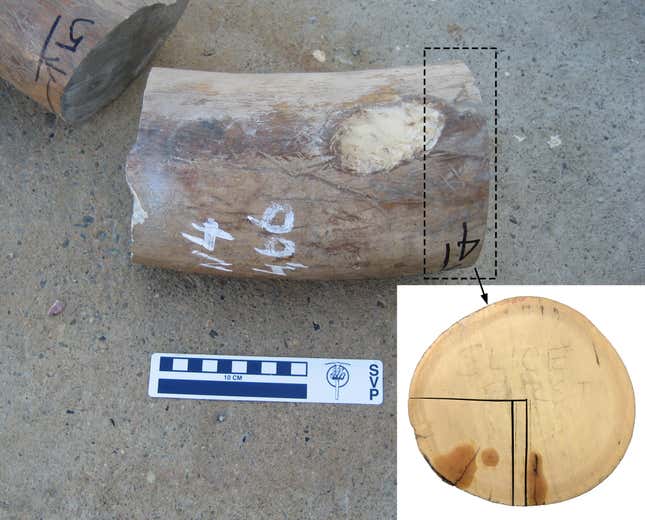
The animal kingdom is full of sexual competition, and extinct creatures are no exception: Researchers found evidence that male woolly mammoths experienced hormone-induced states of aggression towards their rivals, much like modern bull elephants.
This phenomenon is known as musth, and it describes a state of heightened sexual activity and aggression in male elephants. A team of researchers examining a 33,000-year-old mammoth tusk found annual surges in testosterone and other steroid hormones, suggesting that male mammoths also experienced musth. Their research is published today in Nature.
“Tusks hold particular promise for reconstructing aspects of mammoth life history because they preserve a record of growth in layers of dentin that form throughout an individual’s life,” said Daniel Fisher, a paleontologist at the University of Michigan and a co-author of the research, in a university release.

Just as the annually accumulated rings of a tree encode climate information, the concentric rings inside the tusks of proboscideans encode information about their growth. Because tusks are really elongated teeth, they also contain isotopic information from which researchers can glean details of the animals’ lives: where they lived, what they ate, and how they died.
Last year, a team that included Fisher was able to track the lifetime movements of a 34-year-old mastodon named Fred, which died about 13,000 years ago. Fred ended up being killed by another mastodon, based on a tusk-shaped hole in his skull. Based on the timing of Fred’s death—he died in spring—researchers believe the mastodon’s life ended in a struggle over sexual competition.
Mastodons are not mammoths, but it stands to reason that feisty competition among males also occurred in the latter group.
In the recent study, the team sampled and scrutinized tusks from an African bull elephant, a male mammoth, and a female mammoth. They extracted steroids from the dentin in the proboscideans’ tusks and found that the male mammoths shared the same patterns of growth.
The female mammoth (which lived about 5,750 years ago, give or take 150 years) didn’t show signs of increased testosterone levels, while the males did.
Musth “provides a starting point for assessing the feasibility of using hormones preserved in tusk growth records to investigate temporal changes in endocrine physiology,” Fisher said in the release.
Better understanding these lost animals on a hormonal level can help scientists make conclusions about their behaviors in life. That knowledge may become even more relevant as groups hatch plans to create proxy species for mammoths.
Larger projects to understand the interconnectedness of mammalian life are also informed by this discovery. Mammoths may have gone extinct about 4,000 years ago, but their tusks reveal just how similar they were to living elephants—at least as far as being horny is concerned.
More: ‘Gasps’ as Scientists Reveal Preserved Baby Woolly Mammoth